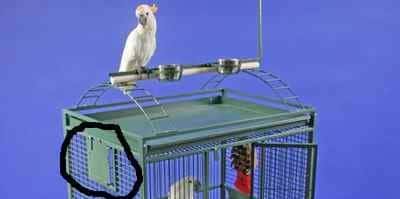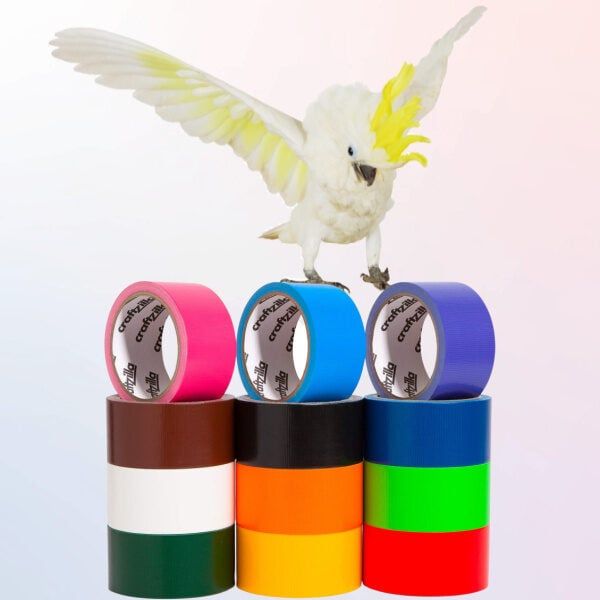Last Updated on by Mitch Rezman
Anatomy of a Bird Cage – Why Are They Made Like That?
Having sold bird cages for almost 20 years it’s easy to assume that our customers know bird cages, but we don’t want to take anything for granted.
With spring around the corner, people begin to think about getting new bird cages or replacing older cages.
Birdcage design much like our knowledge base of exotic birds and parrots has improved enormously over the same period. So we thought it would be a good time to explore what goes into the thinking of designing and building a bird cage.
Material
Depending upon whether you’re going to house a small bird or a large parrot may determine if you’re going to get a “wire” cage or a wrought iron cage. This first decision is usually based on budget because you can put small birds in a wrought iron cage but wire cages are typically less money.
Wire cages are less expensive because they’re made out of just “a wire ” usually with a plastic base. These cages are suitable for small birds like Canaries, Finches, Lovebirds Cockatiels, and some small Conures. Some come with stands and many do not.
For those that don’t come with stands, placement is usually on a table or other piece of furniture. They are lighter than wrought Iron cages so picking them up to clean around is not a big problem.
The coating on the wire or wrought iron cage can either be paint or powder coat. Just because a bird cage is powder-coated doesn’t make it a good cage. Stick with reputable manufacturers and if you buy your cage online make sure the website is trustworthy. Reputable manufacturers such as Prevue & AE have been producing bird cages for many years and can guarantee you that the cages they make are bird-safe.
Stainless steel bird cages have the advantage of lasting much longer than wrought iron cages and can be placed out of doors for extended periods of time. Although desirable for these properties the hefty price usually discourages stainless steel as the material for your cage.
The front and back walls of wrought iron cages will usually have square tubular metal forming a rigid frame. The vertical pieces or what we refer to it as the bars of the cage can be made of thick wire or actual wrought-iron bars growing in thickness based on the size of the housed bird.
Most wrought iron bird cages come with either a stand with casters or have casters attached directly to the bottom of the frame components. Wrought-iron cages are heavy thus it’s easier to move a cage on casters when cleaning. For the purpose of this discussion, we will focus on wrought iron birdcages
The Top of the Cage
The tops of bird cages typically come in two flavors, dome top bird cages and play top bird bird cages. Dome tops that open and can have a perch inserted into the open dome doors temporarily, can be considered a play top as well.
Your choice between a dome top and a play top can be based on functionality or form. Dome tops look less utilitarian than play top bird cages and having an attractive style can help offset looking at all this metal in the room.
Play top bird cages provide space for your bird to perch once out of the cage. In most cases, play top cages provide feeding cups, a ladder for access and a tray to collect refuse and poop.
One of the drawbacks to having the tray on the top of the cage is that it blocks light. Many captive bird owners remove this tray to allow more light into the cage. Placing a piece of newspaper on top of the cage when the bird is out on the play top can replace the need for having the tray as long as the newspaper is replaced with each play top visit.
Play top cages are also practical when you don’t have the space for a play stand for your bird. When your bird comes out of the cage it needs a place to go. If you’re going into another room and your bird’s out of the cage, they’re going to want to come with you and you have to put them somewhere.
If your bird is perching on the back of a chair or desktop, it will only lead to grief for you. If your bird is going to spend most of its time outside the cage in the same room the cage is in, in most cases, all you need is a playtop cage.
Dome tops give your bird more “headroom” because there’s more area in the top of the cage. Birds spend more time in the top third of the cage than anywhere else. Having a dome top bird cage is especially important for long-tail Macaw parrots because of their overall length.
Note: It’s important to keep the overall height of the birdcage in mind as we’re reminded here by the CEO of Prevue Pet Rick Savitt: “Mitch and Catherine: Thanks for the positive critique on the cages and differences the other day. One thing I’d like to point out to you is that our overall heights on the Cages are intentionally lower than the competition.
Not due to cost, but to bring the birds closer down to handling and eye level, so they are not in a dominant position, when outside of the cage on their playpens and therefore are easier to work with by their owners. This is an important feature which was done on purpose”.
Remember birds like to be up high and they don’t know dome top cages are not designed for them to be on top but inevitably they will find their way. If the top doesn’t open, placing a piece of newspaper over the dome will reduce cleaning chores later.
Entry Doors
Before we get into a discussion about entry and feeder doors I’d like to point out the breeder box door that many people see but really aren’t sure about their function – click here for a thorough explanation of bird cage feeder doors

Bird cage breeder box door? It’s that door (with the circle around it)
Birds have to get in and out of their cages. Birdcage doors come in various shapes and sizes. A larger entry door gives you more access to the bird in a cage while at the same time making it easier for the bird to escape. Although not designed for perching, parrots will spend time on the top edge of the entry door.
Landing doors allow the bird to come out of the cage and if the bird is flighted – give them their own “heliport”. Don’t assume your bird can land well (whether you have a landing door or not) on their cage if they’ve never done it before.
We suggest “flying lessons” if you’re introducing your bird to a cage for the first time. Simply take your bird hold them two or three feet away from the cage and flip your hand slightly making your bird fly to the cage allowing them begin to select their own “landing area”.
Speaking of landing areas, the farther the bird is away from the cage like on top of an entry door, the farther away from the cage is the “landing zone” for poop. Depending upon the size of the bird cage, we recommend placing an office chair floor mat or a sheet of linoleum cut approximately one foot beyond the reach of the poop in order to protect your floor from not only the poop but to prevent the casters marking your carpet or solid surface floor.
Click here for our bird cage bar spacing recommendations. When you have many small birds in a bigger cage having an upper and lower door enables you to access the birds in the top of the cage or the bottom of the cage with less chance of birds escaping.
For larger birds, it’s always recommended to have a lock that helps to defeat their escape. We will never promise you a fully “birdproof” birdcage lock because we don’t know of any, but the one pictured above (bottom center) from Prevue Pet is about the best we’ve seen.
Smaller wire cages as mentioned at the beginning of this article usually have slide-up doors. Don’t think for a minute that the weight of the door can prevent a small bird from opening it and escaping see the video just below) We recommend always using a clip, cable tie, or wire tie to ensure birds don’t escape from these smaller cages.
Feeder Doors
Having a feeder door (far right thumbnail) that allows you to access food dishes without disturbing the bird is almost standard on most wrought iron cages today. They are also helpful if someone besides you cares for your bird. With feeder doors, you’re able to change your bird’s food and water without ever putting your hands in the cage. On the far left is a positive locking mechanism that helps ensure your bird does not defeat the feeder door locks.
Most feeder doors simply have a “gravity lock” (center thumbnail above) which can easily be defeated by a bird – forewarned is forearmed. Funny bird escape video click here. You will find gravity locks installed as “secondary locks” on bird cage entry doors helping prevent birds from escaping easily should you forget to engage the entry door lock.
Floor grate and refuse tray – the bird cage grille
Most bird cages today large and small, come with a “floor grille or grate”. Exotic birds and parrots do not like to walk on flat surfaces for long. They prefer the secure feel of wrapping their feet around the bars of a floor grille. The grille allows food, refuse and poop to fall through into the slide-out refuse tray below. In the Prevue Pet cage pictured above the space between the grill in the refuse tray is surrounded by “cage wall” preventing the bird from going into the refuse tray and doing what we affectionately refer to as “dumpster diving”
Depending upon the height of the cage, it may or may not have a storage shelf or cabinet. Sometimes a storage shelf is actually used to add structural stability to the overall cage.
Birdcage casters
Today almost every wrought-iron cage will have casters directly attached to the frame of the cage or the stand the cage sits on. You can also place a cage that does not have a stand on a TV table or computer stand to have mobility. Being able to move the cage is important when it comes to cleaning under and behind it.
What Size Cage?
With small birds, it’s important to keep in mind birds travel side to side so you want to have a cage that is wider than is taller. Larger birds typically will not be flying in their cage. Much has been written about the “proper” size of the cage for parrots. Many times you will hear or read “Get the largest cage that you can afford.”
We will tell you it depends upon your home and your lifestyle as it relates to your birds. Several years ago I delivered a birdcage to a woman who just had acquired a Military Macaw. Upon arriving at her home I discovered that the Military was now the sixth Macaw in her family. She had a Hyacinth, 2 Green Wings and 2 Blue and Golds. The biggest cage bird room wasn’t more than 30 inches in diameter.
Most people (who know birds) would gasp at that fact. But I arrived there late and by the time I got the new cage in the house it was birdie bedtime. The woman clapped her hands and said in a strong voice “Good night everyone it’s bedtime good night birds” and the 5 Macaws dutifully climbed into their cages and patiently sat while she closed and locked all the cage doors. The Military Macaw being new, took some coaxing.
She went on to explain that she worked from home and got up at six in the morning every day and let the birds out which is where they stayed until about eight o’clock every evening so they were happy to crawl into their “sleeping” cages.
So if your bird is going to be in the cage for many hours a day, yes it’s best to have as big a cage you can afford that will fit in your home without overtaking your home. If your bird is going to be out of the cage most of the day, the size and the cage will matter less.
Written by Mitch Rezman
Approved by Catherine Tobsing
Your Zygodactyl Footnote
Author Profile
Latest entries
 The Traveling BirdJune 26, 2025Can You Name 5 Parrot Species That Are Living Wild in the USA?
The Traveling BirdJune 26, 2025Can You Name 5 Parrot Species That Are Living Wild in the USA? Bird BehaviorJune 26, 2025How is it Parrots Are Problem Solvers Social Animals and Even Use Tools?
Bird BehaviorJune 26, 2025How is it Parrots Are Problem Solvers Social Animals and Even Use Tools? Bird & Parrot AnatomyJune 25, 2025How a Tiny Chemical Modification Makes Parrots Nature’s Living Paintings
Bird & Parrot AnatomyJune 25, 2025How a Tiny Chemical Modification Makes Parrots Nature’s Living Paintings PigeonsJune 20, 2025How Do Parrots Thrive in Cities Outside Their Native Habitats?
PigeonsJune 20, 2025How Do Parrots Thrive in Cities Outside Their Native Habitats?





Sookiebird
3 Apr 2017Loved the video on cage cleaning. I do mine pretty much the same way. I do a big clean once a week and change papers every two days.
WindyCityParrot
3 Apr 2017Thank you – the budgies are into millet so If I don’t vacuum every couple of days it gets out of hand
Sookiebird
6 Apr 2017Love your newsletter!
WindyCityParrot
6 Apr 2017thankyou Sookiebird
WindyCityParrot
6 Apr 2017thank you Sookiebird
Nan Nan
6 Apr 2017Thank you for your excellent article on cages. I have a couple of questions for you.
I noticed, in your video on cage cleaning, that the cage with the budgies has a grate bottom, but the parrot cage does not. I was wondering whether I could remove the grate from my amazon’s large cage — I find the grate to be the most difficult part of the cage to clean, but I always figured that it was there for a purpose and by keeping the bird away from the detritus that falls to the bottom essentially made a healthier bird. Which birds need the grate and which can do without? This leads to my second question, regarding the design of cages. Why don’t cage manufacturers provide a way to open the entire front of the cage (or at least an option for a wider double door) which would make cleaning much easier? Thanks again, for providing this great forum for discussion.
WindyCityParrot
6 Apr 2017I appreciate the kind words
We are anti grate Nan Nan – we’ve pulled the grate from the budgies cage. The tray gets fresh news paper every day. The Sennies grate is tough to remove so we layer paper and remove a sheet daily keeping things tidy.
You could follow either path, cover the grate or remove it and cover the the tray – either way you’ll clean less.
There was a line of cages where the whole front swung open but it was discontinued. A problem with a swing out front is easy escape for a bird